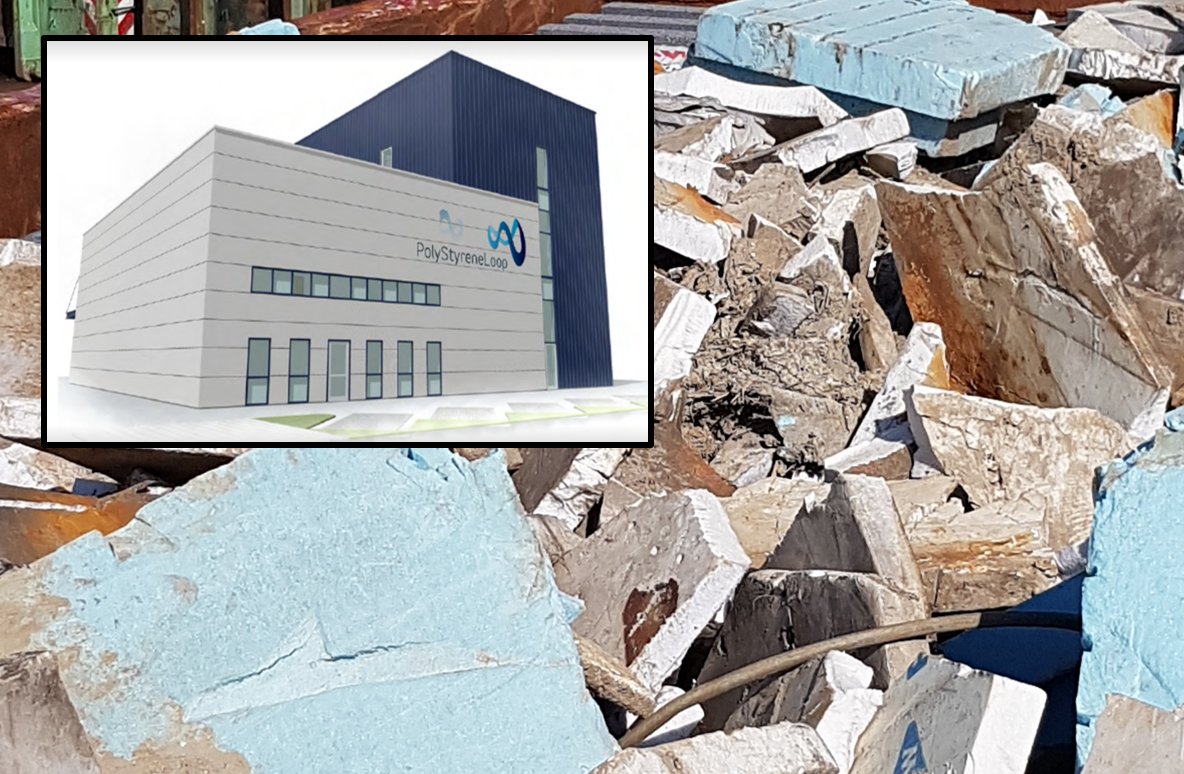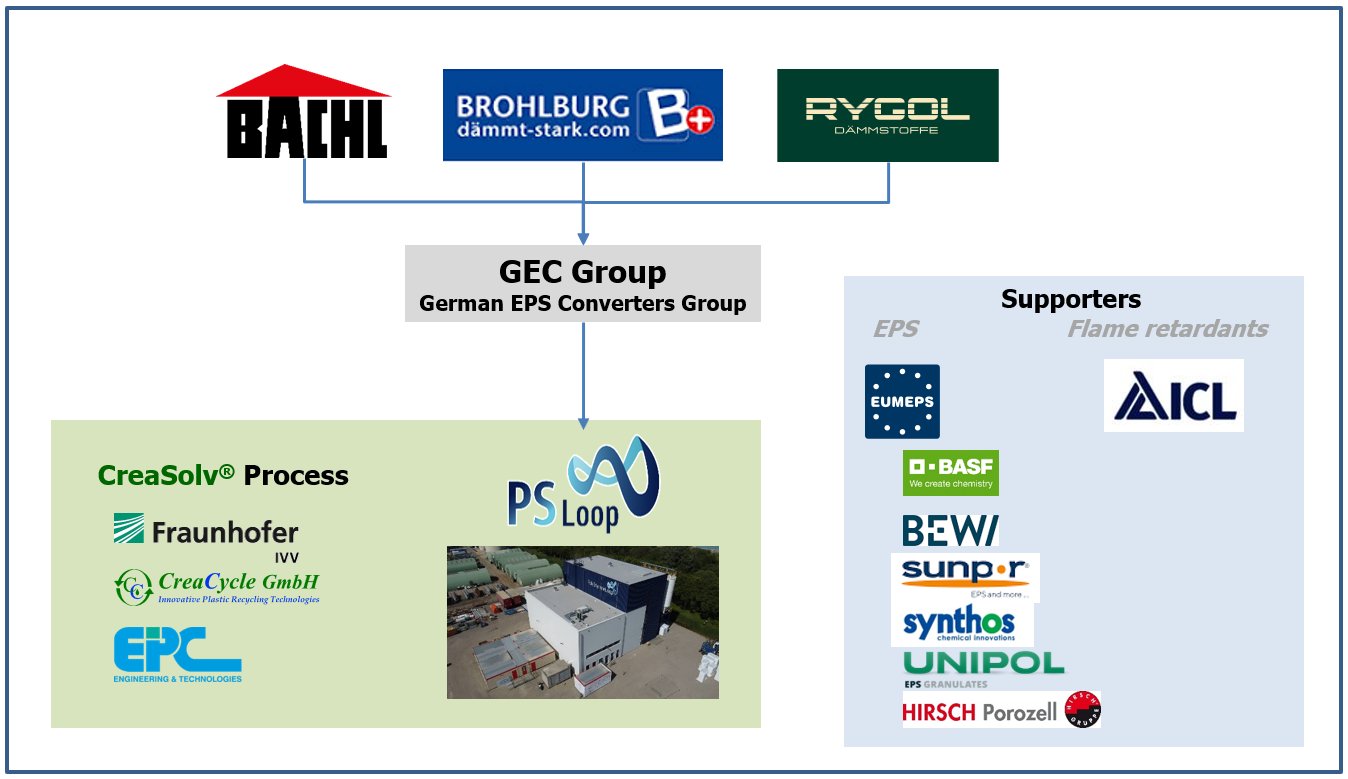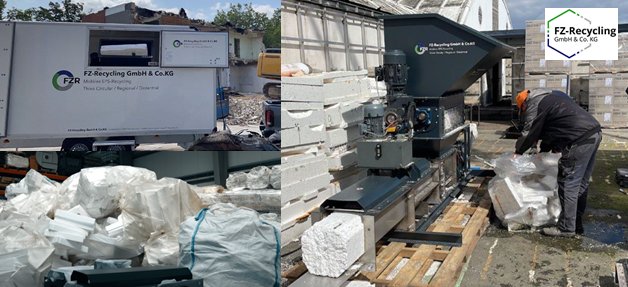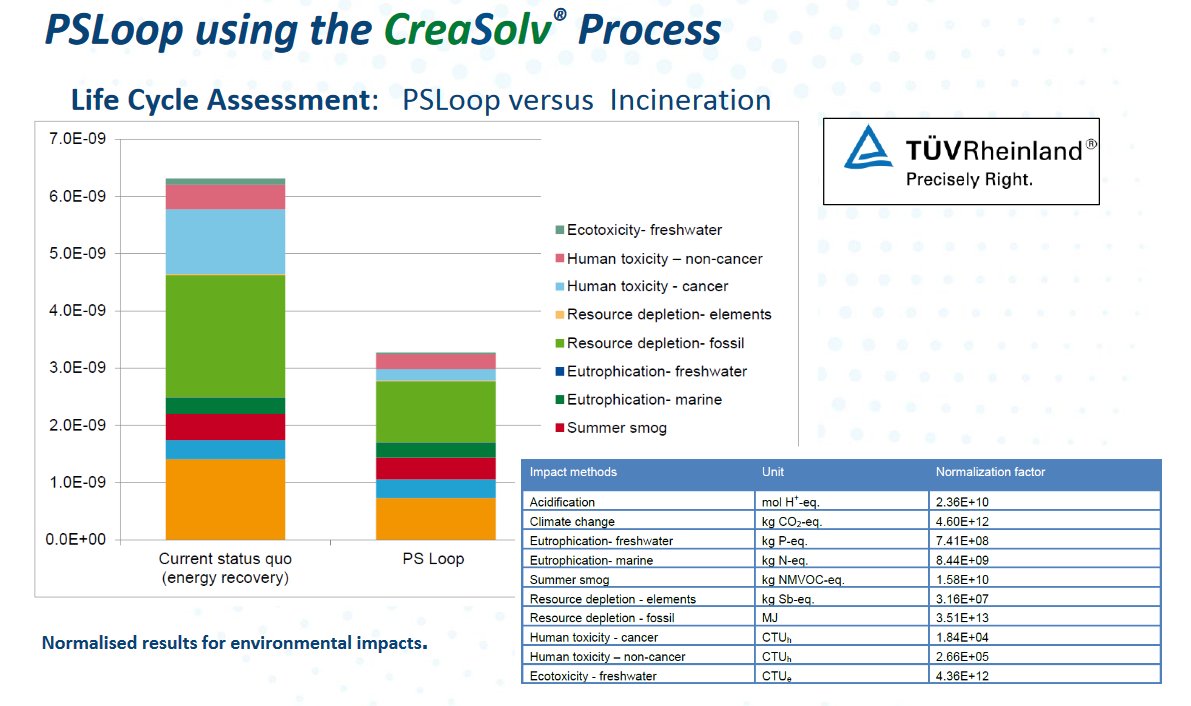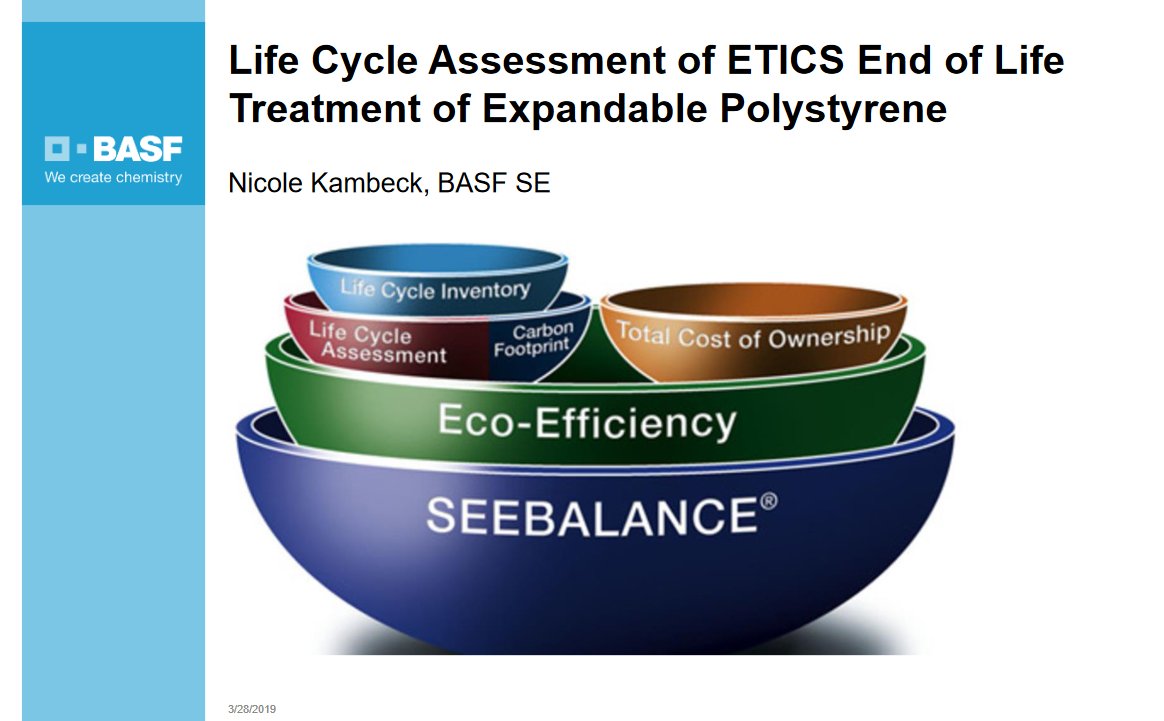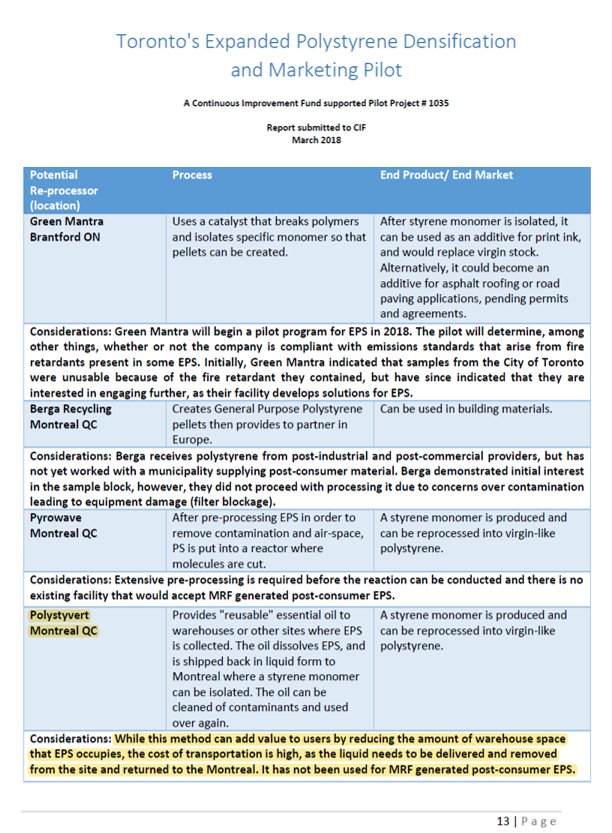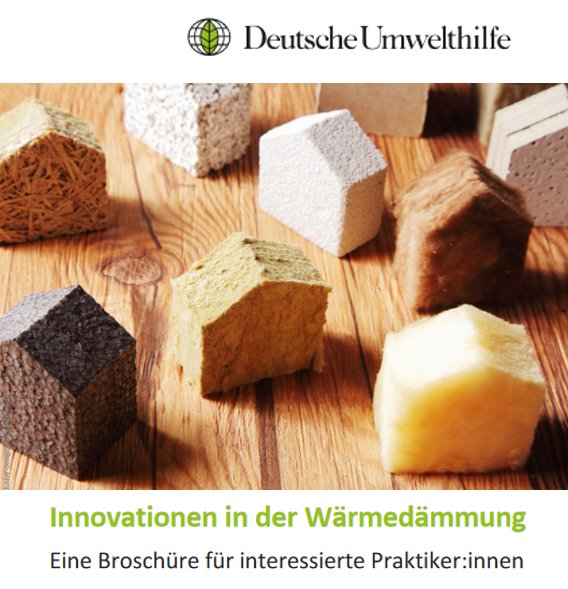CreaSolv® Demonstration Plant for EPS Recycling with POP-Separation
A Dutch cooperation set the goal, to build a CreaSolv® Demonstration plant, in order to recycle External Thermal Insulation Composite Systems (ETICS) and interior thermal insulation systems with flame retardants in a way that the today banned hexabromocyclododecane (HBCD) is removed and recovered polystyrene meets the Basel POP Guidelines1). HBCD was one of the most common flame retardant used in insulation, textiles and electronics.
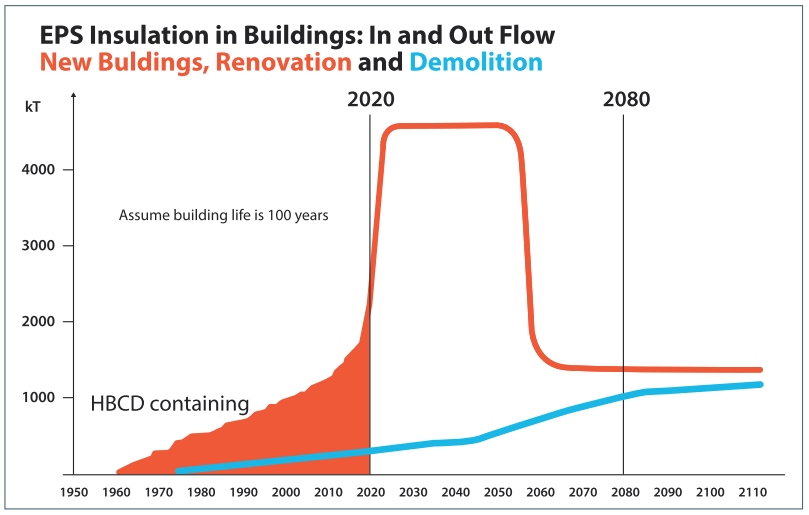 The Problem - Since more than 50 years EPS is used as insulation material2,3) in buildings. With an expected lifetime of 40 - 60 years4) this will lead to increasing EPS deconstruction waste volumes of 2 - 4 million tons per annum containing HBCD in the medium term. In 2013 HBCD was classified as POP (persistent organic pollutant) under the UN Stockholm Convention and listed as restricted chemical. Production and placing on the market are prohibited. Mechanical recycling is no longer possible for such wastes and only a costly incineration remains.
The Problem - Since more than 50 years EPS is used as insulation material2,3) in buildings. With an expected lifetime of 40 - 60 years4) this will lead to increasing EPS deconstruction waste volumes of 2 - 4 million tons per annum containing HBCD in the medium term. In 2013 HBCD was classified as POP (persistent organic pollutant) under the UN Stockholm Convention and listed as restricted chemical. Production and placing on the market are prohibited. Mechanical recycling is no longer possible for such wastes and only a costly incineration remains.
PolyStyrene Loop Cooperative
November 2017 - Inauguration of the PolyStyreneLoop (PSL) Cooperatief with currently over 70 members in Amsterdam. The members (entities and trade associations) from 13 countries cover the whole polystyrene value chain. The funding of the project comprises the following:
- The Cooperative raises € 3.6 million.
- The EU LIFE Programme grants a subsidy of € 2.7 million.
- The Province Zeeland grants a subsidy of € 1.0 million.
- The RABO Bank confirms a loan of € 4.5 million.
- The National Groenfonds confirms a loan of € 2.5 million.
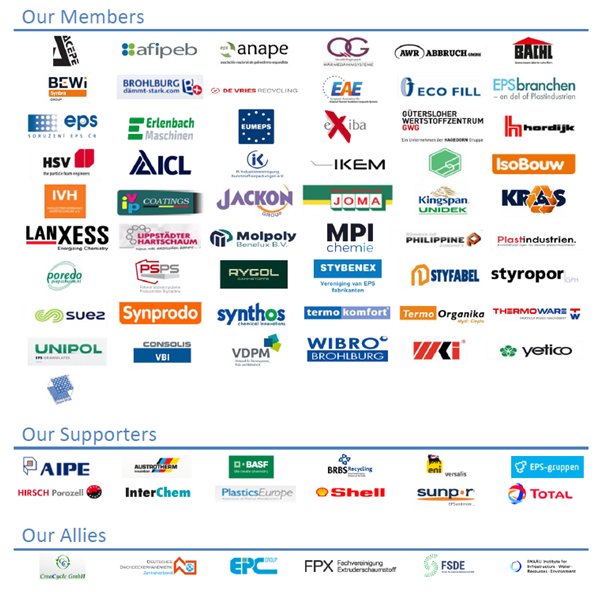 In order to support the Cooperative in an optimum way Fraunhofer IVV, CreaCycle and EPC Engineering & Technologies combined their competencies in a cooperation, in which EPC will be the primary contact for PSLoop, because the plant engineering is a focal point.
In order to support the Cooperative in an optimum way Fraunhofer IVV, CreaCycle and EPC Engineering & Technologies combined their competencies in a cooperation, in which EPC will be the primary contact for PSLoop, because the plant engineering is a focal point.
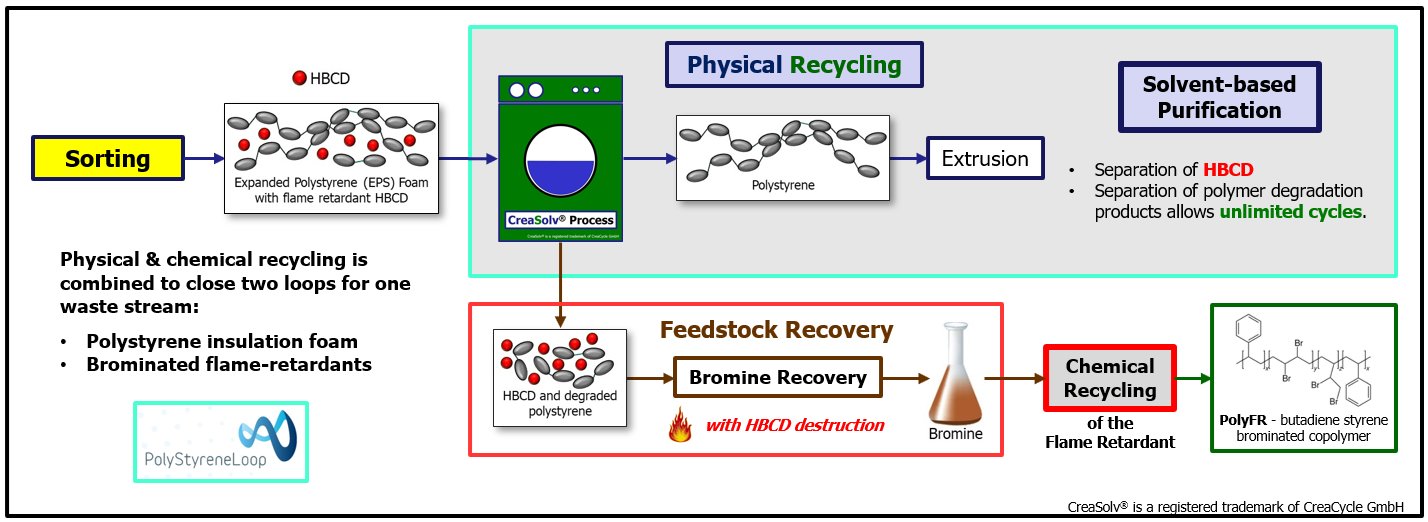 The basic engineering for the CreaSolv® Demo plant to be built next to the premises of ICL-IP (PSL member with bromine recovery unit) in Terneuzen was carried out by EPC under license from Fraunhofer IVV and CreaCycle supplies proprietary CreaSolv® Formulations.
The basic engineering for the CreaSolv® Demo plant to be built next to the premises of ICL-IP (PSL member with bromine recovery unit) in Terneuzen was carried out by EPC under license from Fraunhofer IVV and CreaCycle supplies proprietary CreaSolv® Formulations.
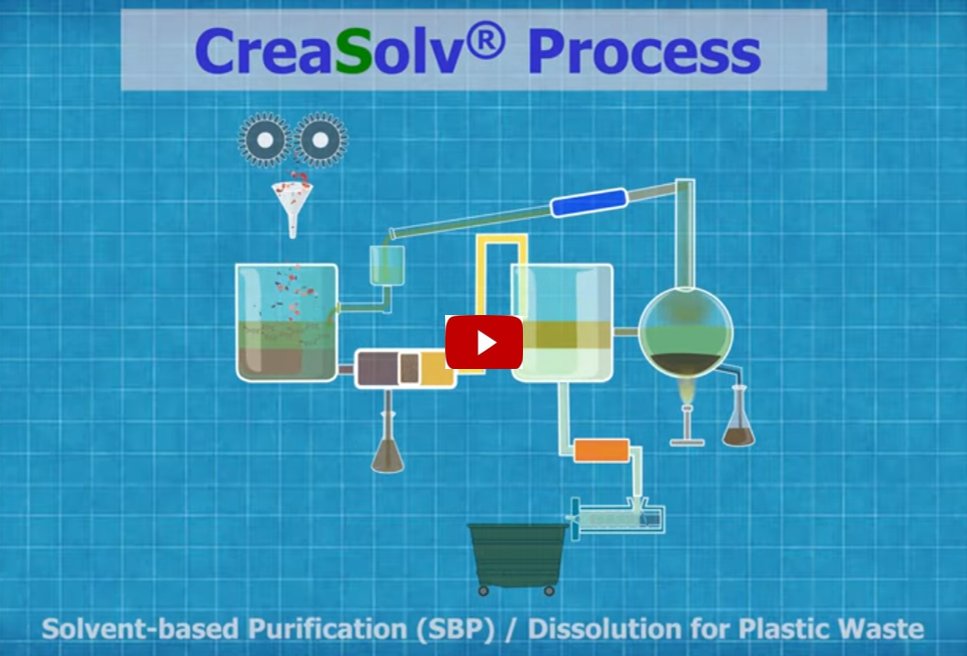 PolyStyreneLoop is based on the CreaSolv® Technology, a Solvent-based Purification / Dissolution Recycling (developed by Fraunhofer IVV in cooperation with CreaCycle GmbH), allowing the separation of polystyrene from legislated HBCD and other additives with Physical Recycling (synonym; Material Recycling). This process recovers the polystyrene, which can be REUSED in new construction products.
PolyStyreneLoop is based on the CreaSolv® Technology, a Solvent-based Purification / Dissolution Recycling (developed by Fraunhofer IVV in cooperation with CreaCycle GmbH), allowing the separation of polystyrene from legislated HBCD and other additives with Physical Recycling (synonym; Material Recycling). This process recovers the polystyrene, which can be REUSED in new construction products.
HBCD is further treated in the Bromine Recovery Unit from ICL and the recovered bromine can be used to produce also new flame retardants again.
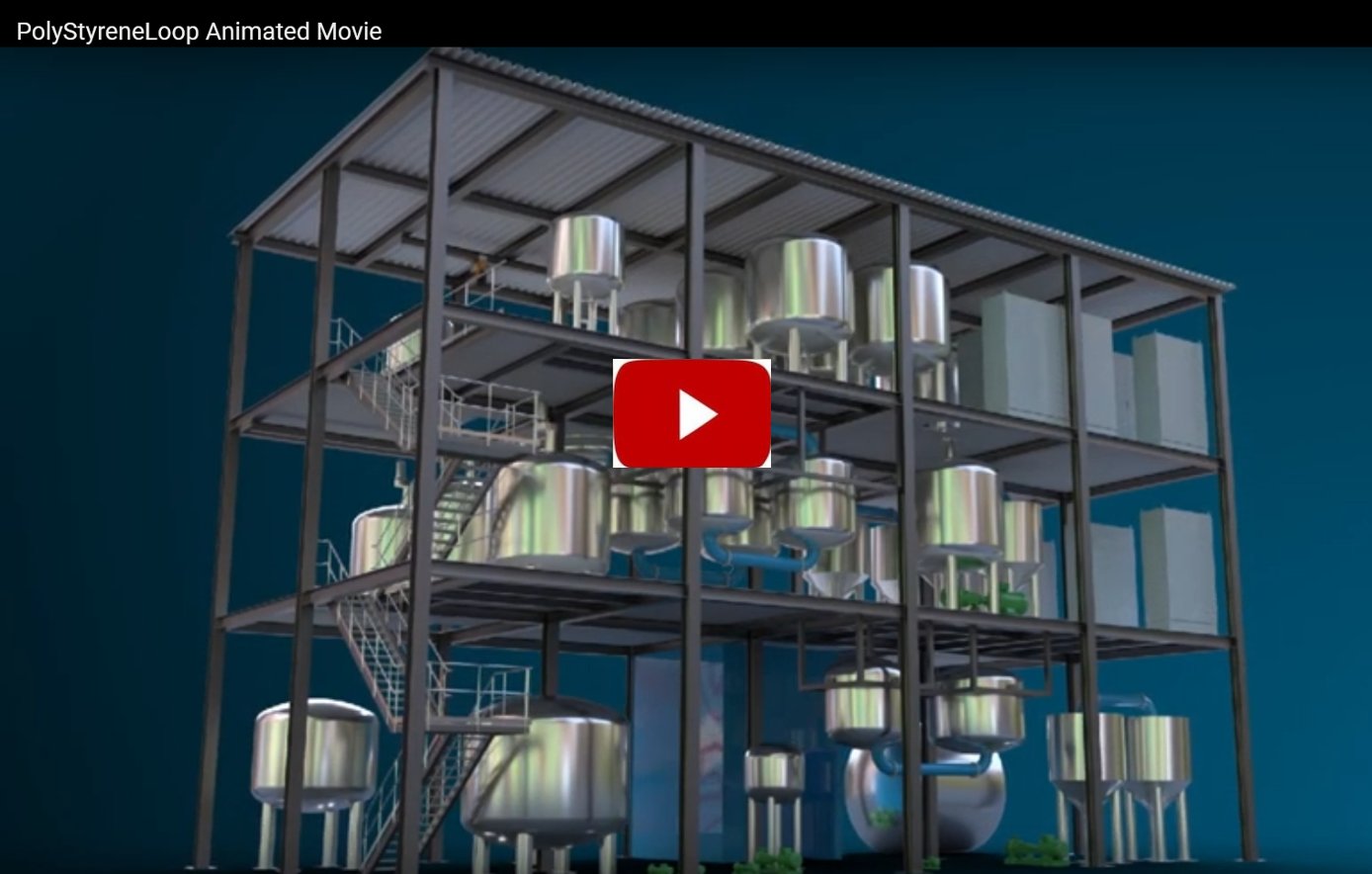 In the “Poly-Ressource” project (2010) it was already shown that the CreaSolv® Process removes flame retardants from electro(nic) waste (WEEE) and in a project carried out on behalf of PSL member Sunpor in 2014, it was demonstrated that the HBCD removal efficiency of the CreaSolv® Process was >99,7% and the recycled polystyrene (HBCD < 100ppm) was converted to new prime Lambdapor® EPS.
In the “Poly-Ressource” project (2010) it was already shown that the CreaSolv® Process removes flame retardants from electro(nic) waste (WEEE) and in a project carried out on behalf of PSL member Sunpor in 2014, it was demonstrated that the HBCD removal efficiency of the CreaSolv® Process was >99,7% and the recycled polystyrene (HBCD < 100ppm) was converted to new prime Lambdapor® EPS.
December 2019 – Finally, the financing of the plant is secured and the PSLoop consortium starts construction of the plant with a delay of 2 years. The company ENGIE (today Equans) acts as plant constructor. In parallel, the establishment of collection points for EPS waste (Hubs) in Germany and the Benelux countries is started.
16 June 2021 – Despite Corona and global supply bottlemecks inauguration of the PSLoop demoplant (as scheduled), that will be able to convert over 3300 metric tonnes of polystyrene foam waste per year, based on a physical waste pre-treatment process, which reduces carbon emissions by approximately 50% compared to the current disposal via incineration with energy recovery.
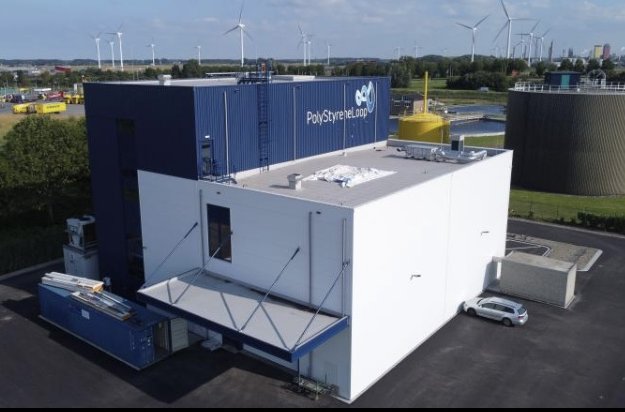
Now the interconnection and testing of the individual plant components and process steps, as well as the training of the personnel starts. In this phase of the start-up, defective delivered elements (such as pumps, heaters, piping, etc.) are identified and replaced. Only when all individual process steps are functioning properly, they can be combined and checked and accepted as a complete system.
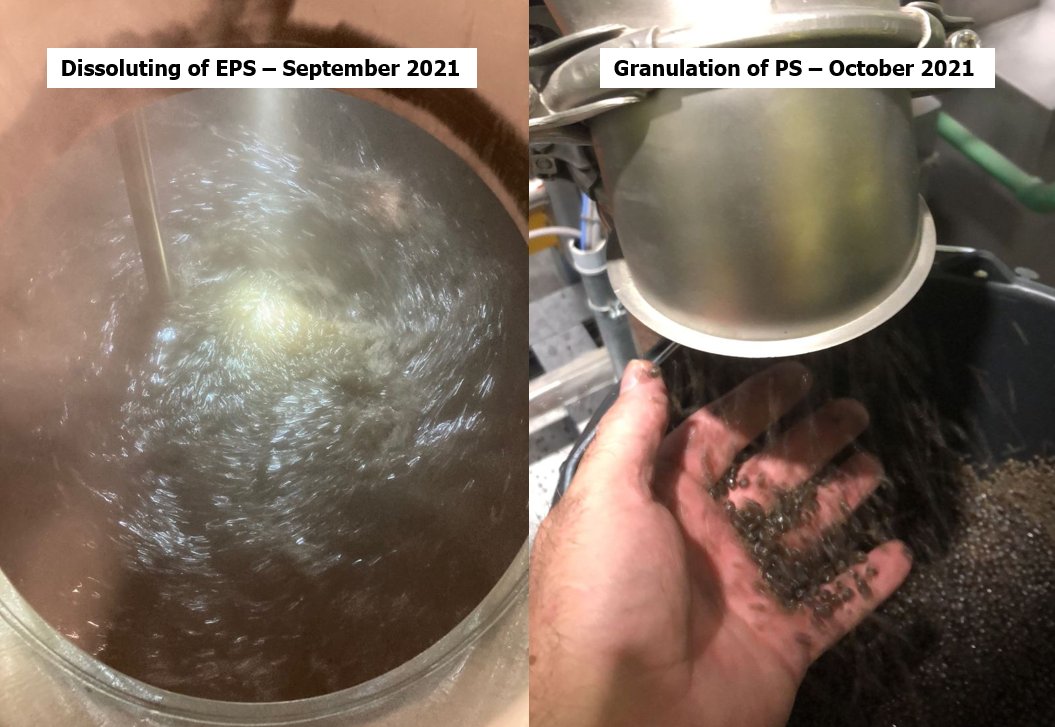
The pre-commissioning acceptance has been completed for dissolution of EPS, precipitation, drying and extrusion of the recycled PS before end of the year. All ancillary equipment has not yet been accepted and no process optimization has yet taken place.
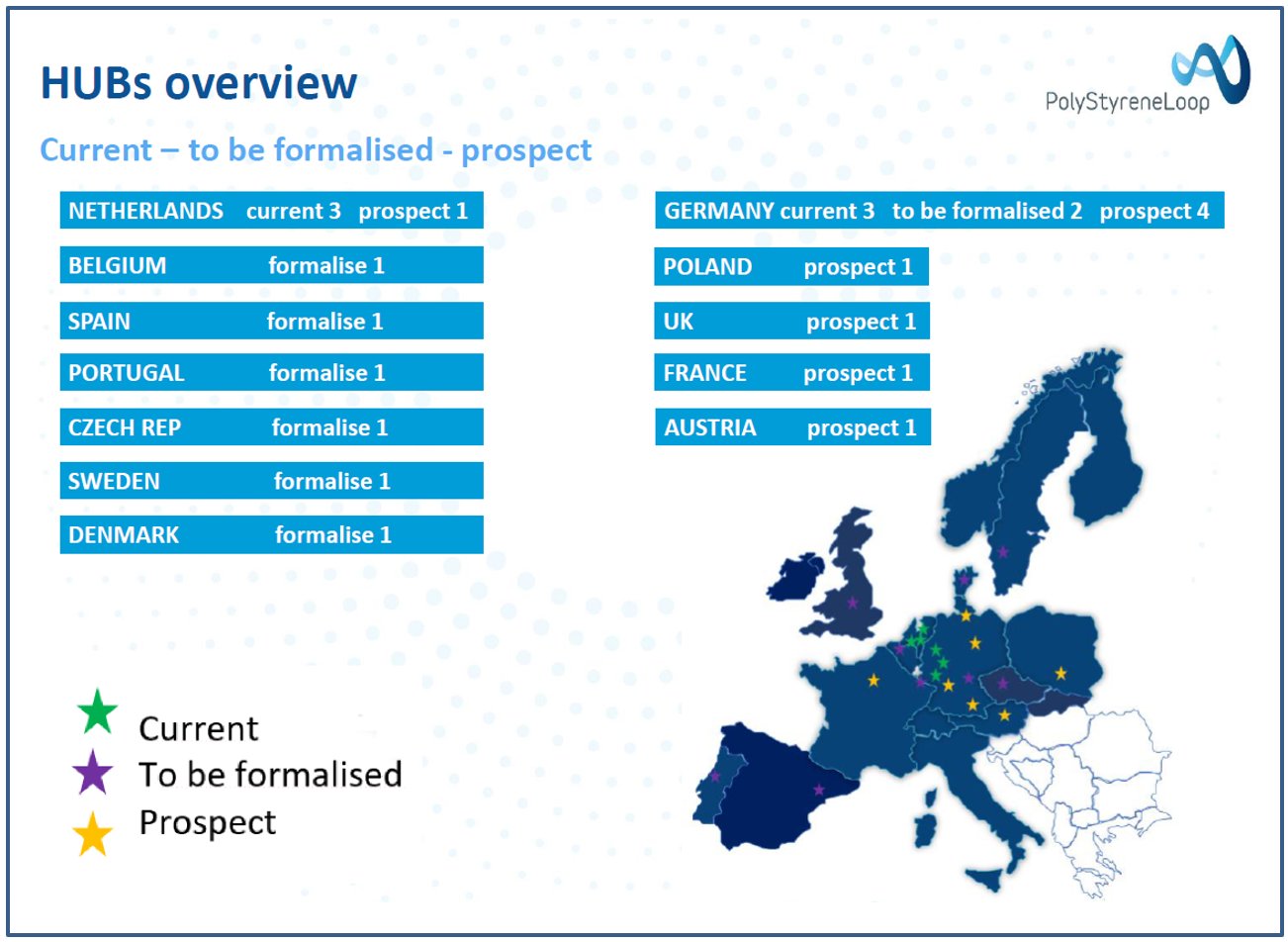 The European network of certified PSLoop collection points currently consists of 3 HUBs each in Germany and 3 in the Netherlands, with 8 more in the process of certification.
The European network of certified PSLoop collection points currently consists of 3 HUBs each in Germany and 3 in the Netherlands, with 8 more in the process of certification.
8 March 2022 - The unprecedented events of the last 2 years, with COVID related problems and soaring energy prices, combined with a number of delays during the startup contributed to severely impact liquidity, thus causing bankruptcy of PolyStyreneLoop B.V.
22 June 2022 – The German consortium GEC (German EPS Converters) has purchased the Dutch demonstration plant and established the new company PS Loop B.V., a 100% subsidiary of the GEC Group. The GEC group comprises of the German EPS converters Bachl, Brohlburg and Rygol, which are supported by the EPS Raw Material Suppliers BASF, Bewi, Sunpor, Synthos and Unipol as well as the Austrian EPS converter Hirsch and the flame-retardant manufacturer ICL-IP, all working together in the European association EUMEPS (European Manufacturers of Expanded Polystyrene).
30 May 30 2023 - FZ-Recycling & Co. KG carries out the 1st cross-border delivery of HBCD-containing EPS waste (according to the Basel Convention) from Germany to Terneuzen. The company is a member of the PS Loop Cooperative and has EPS compaction systems (compression 50:1) in use to optimize transport logistics. This supply line is important as not enough EPS containing HBCD is collected in other European countries to fill the plant to capacity.
12 June 2023 – The first industrial plant for recycling EPS insulation materials goes into regular operation and the CreaSolv® Technology enables PSLoop to recycle HBCD-containing polystyrene foams on an industrial scale.
15 February 2024 – PSLoop has successfully achieved a major milestone by continuously producing 5 tons recycled polystyrene per week from EPS construction waste containing the legacy flame retardant HBCD. Test results have proven that the Loop PS Recyclate remains well below the UTC, the Unintentional Trace Contaminant value of 100 mg/kg HBCD. This is crucial as it enables Loop PS to meet the regulatory requirement for REUSE in EPS/XPS construction applications.
Loop_PS is now being converted into new EPS beads by the project partners and these beads are then moulded into new insulation boards exclusively by GEC, shareholder of PS Loop B.V.
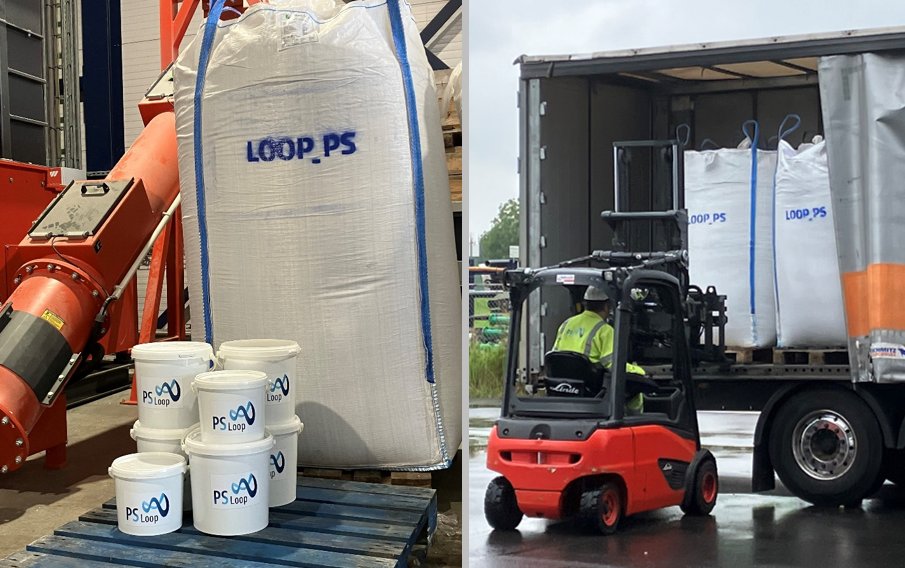
29 March 2024 – The CreaSolv® Demonstration plant has proven that it can successfully remove the legacy flame retardant HBCD from Expanded Polystyrene (EPS) waste. PSLoop has managed to continuously run their production process in the medium scale demonstration plant, producing LoopPS Recyclate.
The project managed to fulfill the UN requirements for UTC (unintentional trace contaminant). This is crucial as it enables the recycled material to meet the regulatory requirement for use in EPS/XPS construction applications, and indeed the Loop PS Recyclate has been successfully converted into new EPS raw material, and subsequently molded into insulation boards.
Hence it has been demonstrated for the first time ever that closed loop recycling is possible with deconstruction EPS waste containing HBCD.
PS Loop has thus proven its technical readiness level for investment in future commercial scale recycling plants. The outstanding milestone of destruction of the removed HBCD (as required by the Basel Convention Technical Guideline) with recovery of bromine for use in production of sustainable polymeric flame retardant will be finalized over the coming weeks, and will be executed using already proven bromine destruction and recovery technology of ICL-IP.
Having achieved the main objective, the stakeholders have now decided to look for external investors for PS Loop.
Like several other recycling units in Europe, PSLoop has struggled with high energy costs, the bureaucracy and uncertainty of legislation for the handling of waste and in particular for trans-border waste shipments. The situation is exacerbated by the industry facing increasing imports of cheap virgin polymers. This impedes the competitiveness of recyclates produced in Europe, thus making it more challenging for PS Loop to produce a competitively priced product.
The successful demonstration of this technology has resulted from good cooperation of only a handful of EPS raw material producers, converters and a flame retardant manufacturer but is in particular the result of the dedication, hard work and commitment of all the staff at PS Loop and its shareholder, the GEC Group.
The stakeholders remain committed to recycling EPS, and in particular to the innovative CreaSolv® Process which they believe has the potential to revolutionize the circular economy for plastics.
Basel Convention
The Basel Convention is an international environmental treaty on the Control of Transboundary Movements of Hazardous Wastes and Their Disposal.
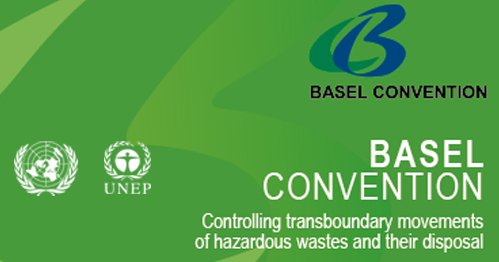
In order to build a demo plant for HBCD containing EPS with bromine recovery10), the CreaSolv® Process needs to be incorporated in the Basel Convention Technical Guidelines as an alternative End of Life (EOL) option besides incineration.
May 2017 - DISSOLUTION for the separation of polystyrene and HBCD has been included as BAT (Best Available Technique) for waste treatment, based on information about the PolyStyreneLoop project with the CreaSolv® Process in the sections "Pretreatment" (Dissolution, sedimentation and distillation) and "Hazardous Waste Incineration" (regarding the destruction of HBCD) of the Basel Convention Technical Guideline20,11).
From now on it is no longer mandatory to incinerate all EPS construction waste because it contains approx. 1% HBCD. The door has been opened to alternatively separate polystyrene from HBCD in order to REUSE THE POLYMER and recover bromine, thus closinge 2 circles at the same time.
Life Cycle Assessments (LCA)
March 2017 – TÜV Rheinland conducted a Life Cycle Assessment (LCA) 1-pager22) comparing incineration with physical recycling with the intend to validate the CreaSolv® Process as an additional credible end of life option for ETICS (External Thermal Insulation Composite Systems).
This study23) concludes that the PSLoop process shows a lower environmental impact in the categories climate change, eutrophication (freshwater), summer smog, resource depletion (fossil elements), human toxicity (non-cancer, cancer) and freshwater ecotoxicity in comparison to incineration with energy recovery.
November 2019 - In its study Holistic evaluation of different insulation alternatives23), the ifeu - Institute for Energy and Environmental Research Heidelberg, Germany compared their burdens and benefits through waste life cycle assessments. The comparison of disposal options for EPS and XPS boards (pages 106-110) showed that the physical CreaSolv® Process performed similarly well to regranulation (mechanical recycling). -> Translation
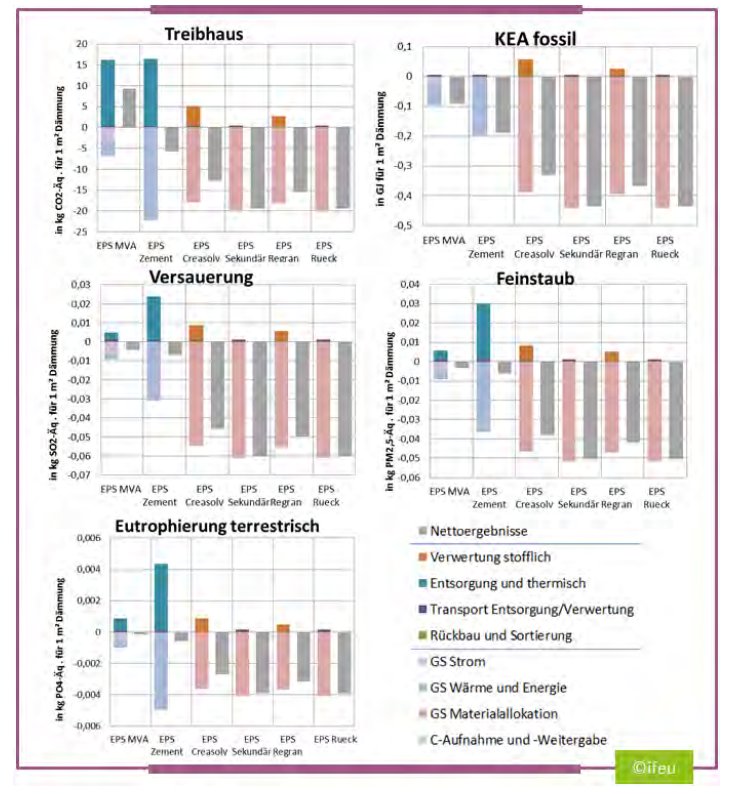
Since HBCD-contaminated EPS and XPS cannot be mechanically recycled (Basel Convention!), the CreaSolv® Process offers the best life cycle assessment of 6 disposal options for both insulation materials and the only possibility to reuse the polystyrene.
April 2022 - In its new study "The Building Stock is facing a Renovation Wave - Insulation Materials must open up the Material Cycle"26), the ifeu Institute analyzed the recycling routes of various insulation materials - including EPS and XPS - and subjected them to an ecological assessment in order to update the life cycle assessments from the 2019 study. -> Translation
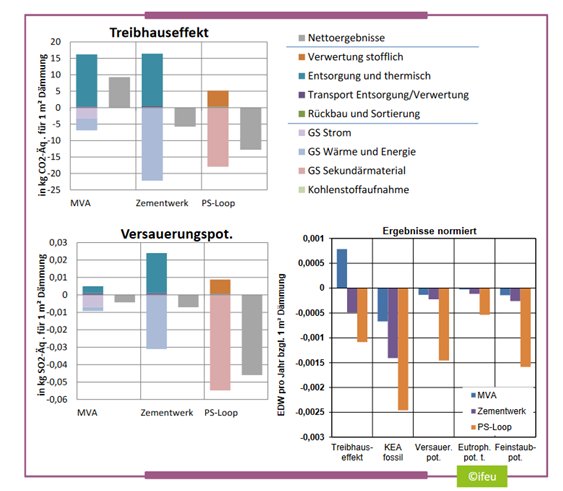
Conclusion for the disposal routes for EPS insulation boards: "In net terms, there is a clear advantage for material recycling via PolyStyreneLoop (CreaSolv® Process) across all impact categories/indicators considered" (Pages 51, 52, 55, 84-86).
Studies
August 2016 - Finalization of the study EPS/XPS Recycling in the Construction Sector on behalf of the Austrian Ministry for the Environment, the Environmental Agency of Upper Austria and Sunpor, available on the homepage of the Government of Upper-Austria15). The comparison of the CreaSolv® Process with EPS waste incineration shows that recycling makes economic sense. 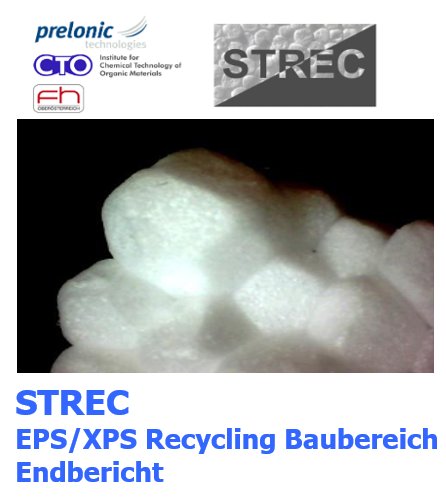
March 2018 - Canada’s largest city Toronto conducted a pilot project to find a consistent outlet for compacted EPS waste27). “After distribution of compressed EPS to potential re-processors for evaluation, no viable market could be established for either the compressed EPS, or standard baled material, with the existing quality”. Plastics processors detected fire retardants in the samples, which are used in insulating foams and the report described their presence as problematic. The consultant also contacted 3 other Canadian companies: GreenMantra Technologies and Pyrowave, which use chemical recycling technologies to break down plastics, and Polystyvert, which uses essential oils to dissolve EPS before later separating it for recycling. “According to the City’s Report28) (see also page 13), issues related to the presence of fire retardants, contamination, freight costs and inexperience processing materials from MRFs (material recovery facility) dimmed hopes that those outlets would regularly take the city’s EPS.”27)
May 2018 – The study “Hexabromocyclododecane in polystyrene packaging: A downside of recycling?”28) reveals that the flame retardant HBCD was present in 90% of 20 Irish and 50 UK polystyrene packaging samples examined. Flame retardants are used in expanded polystyrene (EPS) building insulation materials but not for packaging!
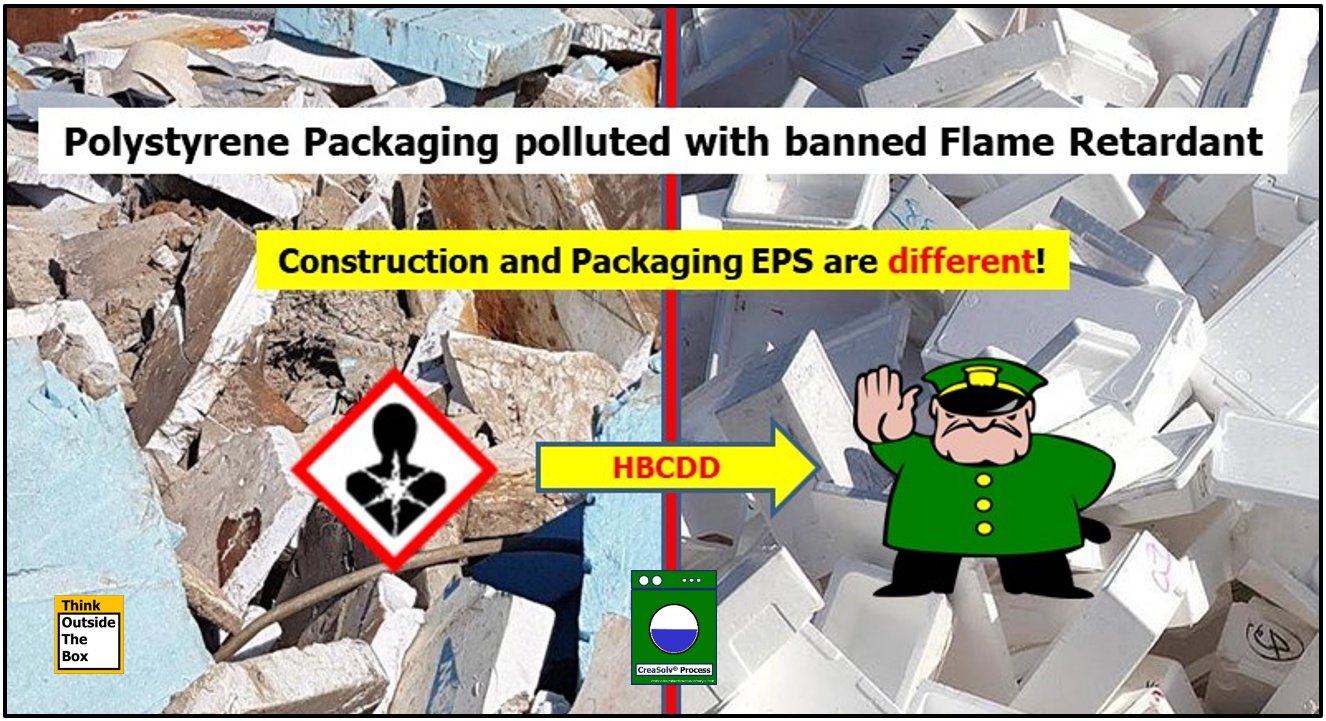
The EU concentration limit for HBCD in articles was 0.01% at the time of the study. 63 of 70 samples (= 90%) contained HBCD and 6 exceeded the limit value. This finding should be alarming in many aspects because it may point to:
- poor or inefficient sorting capabilities and EPS packaging waste being mixed up with EPS insulation waste from demolition containing the flame retardant HBCD (if we exclude that this was done intentionally)
- no or poor incoming control for flame retardants in EPS waste collection
- state-of-the-art recycling technologies like re-granulation cannot separate imbedded impurities or dangerous additives like HBCD and complete combustion is mandatory in appropriate incinerators (this may be costly).
- no or poor quality control for recycled polystyrene (obligation for recyclers under REACH) in general and for packaging end-uses especially
- no or poor control of authorities that regulations are followed
June 2021 - The Deutsche Umwelthilfe (DUH, Environmental Action Germany) provides information on Innovations in Thermal Insulation25) as part of its new "Political Recommendations for Action - Thermal Insulation". This also reports on PolyStyreneLoop (pages 67-71) and that the CreaSolv® Process (classified as Material Recycling) performs significantly better than energy recovery and allows the polystyrene to be reused. "However, since (in Germany) insulation materials containing HBCD are still burned at low cost in waste-to-energy plants, there is no financial incentive to invest in a recycling process. So, recycling of the contaminated insulation boards must either be required by law or be financially attractive."
- Airpop® is a registered trademark of EUMEPS
- Lambdapor® is a registered trademark of Sunpor GmbH
- Styropor® is a registered trademark of BASF SE
PS Loop Homepage - Link
PS Loop Guideline "Collection and Pretreatment - Link
PS Loop - List of Members
Literature
- EUMEPS press release November 2015: Non-profit foundation under Dutch law „PolyStyrene Loop“.- Link
- Isobow Information http://www.isobouw.de/daemmstoff-eps/herstellung.html last check on 20.05.2016
- IVH (Industrieverband Hartschaum e.V.) URL: http://www.ivh.de/FAQ_I2059.whtml last check on 20.05.2016.
- Hessisches Ministerium für Umwelt, Energie, Landwirtschaft und Verbraucherschutz (Hrsg.): Wärmedämmung von Außenwänden mit dem Wärmeverbundsystem, November 2012, S. 8
- Poly-SOLVE URL: http://www.polysolve.eu/ last check on 22.05.2016
- HiPerPol URL: http://www.twi-global.com/news-events/connect/2011/may-june-2011/twi-expertise-in-novel-solvent-development/ last check on 22.05.2016
- M. Schlummer, Hessischer Energieberatertag 2015; „CreaSolv®: Das Recyclingverfahren für Polystyrol“ Link
- Advances in Recycling and Waste Management - published May 15, 2017 - M. Schlummer, A. Mäurer, S. Wagner, A. Berrang, T.Siebert, F. Knappich – „Recycling of flame retarded waste polystyrene foams (EPS and XPS) to PS granules free of hexabromocyclododecane (HBCDD)" - Link
- PolyStyrene Loop Pressemitteilung Mai 2016 “100% recycling of Polystyrene insulation soon to be demonstrated - wide spread industry support for “PolyStyrene Loop”. Link
- PolyStyrene Loop: CreaSolv® Leaflet Mai 2016 – Link
- PolyStyrene Loop presentation at 10th Basel Convention Working Group Meeting in Nairobi, Kenia on 30th May 2016: “CreaSolv® process with BRU destroying the POP substance HBCDD waste and recycling Polystyrene” - Link
- ITAD Interessengemainschaft der Thermischen Abfallbehandlungsanlagen in Deutschland e.V. – „Verwertung von Polystyrol-Schaumstoffabfällen mit HBCD“ – letzter Check 17.09.2016 Link
- Frank E Mark et al „Destruction of the flame retardant hexabromocyclododecane in a full-scale municipal solid waste incinerator“ in Waste management & Research 2015, Vol. 33(2) 165-174 Link
- EUWID – Recycling und Entsorgung 16.09.2016: “HBCD-Entsorgungsengpaß: ITAD fordert pragmatische und umsetzbare Lösungen“ letzter check 19.09.2016 Link
- Ingenieurbüro für Techn. Chemie, DI Dr. Friedrich Eibensteiner et al, „STREC EPS/XPS Recycling im Baubereich“ Endbericht vom 30.8.2016 - Link
- ITAD Q&A – Entsorgung von HBCD-haltigem Polystyrol (Styropor) vom 13. Oktober 2016 - Link
- Baulinks „Alles wieder gut? Bundesrat will befristete Ausnahmeregelung für HBCD-haltige Dämmstoffe“ vom 16.12.2016 - Link
- Stellungnahme der deutschen Umweltverbände DUH, NABU, BUND und DNR zum Referentenentwurf der „Verordnung zur Überwachung von nicht gefährlichen Abfällen mit persistenten organischen Schadstoffen und zur Änderung der Abfallverzeichnis-Verordnung“ vom 27. April 2017. - Link
- Hessisches Ministerium für Wirtschaft, Energie, Verkehr und Landesentwicklung - "hessische energiespar-aktion" Homepage, zuletzt abgerufen am 18.06.2017 - Link
- Basel Convention - Technical Guideline - UNEP/CHW.13/6/Add.1/Rev.1 dated 29 June 2017 - Link
- Beschluß des Bundesrates (959. Sitzung am 7.7.2017) Beschluß 488/17 – Top 81 – Entsorgung von Styropor-Dämmplatten – Link
- 2018.03.16 Results of a Life Cycle Assessment for End of Life Treatment of Expandable Polystyrene (EPS) from External Thermal Insulation Composite Systems (ETICS) - Link
- BASF - Life Cycle Assessment of ETICS End of Life Treatment of Expendable Polystyrene published 28.03.2019 - Link
- Ifeu – Institut für Energie- und Umweltforschung Heidelberg „Ganzheitliche Bewertung von Dämmstoffalternativen“ von November 2019 - Link
- Deutsche Umwelthilfe "Innovationen ind der Wärmedämmung" von 15.06.2021 - Link
- Ifeu – Institut für Energie- und Umweltforschung Heidelberg „Der Gebäudestand steht vor einer Sanierungswelle – Dämmstoffe müssen sich den Materialkreislauf erschließen“ von April 2022 – Link
- Resource Recycling – “Toronto struggles to find market for curbside foam” by Jared Paben posted on August 14, 2018 - Link
- “Toronto’s Expended Polystyrene Densification and Marketing Pilot” Project #1035 from March 2018 – Link
- Chemospere Volume 199, May 2018, “Hexabromocyclododecane in polystyrene packaging: A downside of recycling? By Stuart Harrad et al, pages 612-616 - Link
